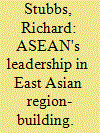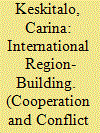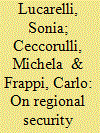|
|
|
Sort Order |
|
|
|
Items / Page
|
|
|
|
|
|
|
| Srl | Item |
| 1 |
ID:
132400


|
|
|
|
|
| Publication |
2014.
|
| Summary/Abstract |
Despite none of its members being a major economic or military power, the Association of Southeast Asian Nations (ASEAN) has played a leading role in building East Asia's regional institutions. In exploring this apparent puzzle, the analysis reviews the literature on state leadership at the regional and international level, asks why the region's major powers ceded leadership on the question of regional institution building to ASEAN, and assesses the consequences for East Asia's regional architecture of ASEAN's leadership role in institution-building. The conclusion is that leadership at the state level entails a state, or a group of states, proposing, executing and getting others to agree on a course of action to deal with a specific problem or challenge. The analysis also underscores the point that, while ASEAN has been the leader in East Asian institution-building, the Association and its members should not automatically be expected to play a leadership role on all issues preoccupying the region.
|
|
|
|
|
|
|
|
|
|
|
|
|
|
|
|
| 2 |
ID:
077428


|
|
|
|
|
| Publication |
2007.
|
| Summary/Abstract |
The Arctic has emerged as a region in international cooperation during the past 20-30 years, as manifest in the creation of the Arctic Council and its predecessor, the Arctic Environmental Protection Strategy, and in the incidence of a host of scientific and political cooperation projects. The region now includes eight states over the circumpolar area; namely, the United States, Russia, Canada and the Nordic countries. How this international region has developed over time is investigated with reference to the conception of regions as understood in region-building discourse. Accordingly, the Arctic as a region that is not natural or given but as constructed by and for particular actors and interests is studied. It is concluded that the regional superstructure includes conceptions of the North that draw on images developed in historical exploration and research, shaped by a discourse of the Arctic representing North American more than Nordic understandings.
|
|
|
|
|
|
|
|
|
|
|
|
|
|
|
|
| 3 |
ID:
151390


|
|
|
|
|
| Summary/Abstract |
Already introduced to the academic and political debate some years ago, the concept of “security governance” still needs to be clarified. In particular, four main shortcomings need to be overcome to make the concept more useful for an assessment of current security dynamics: in the first place, attention has been devoted more to “governance” than to “security”, while failing to consider the role of the understandings and perceptions of the actors involved in the governance system. Second, the literature on the actors (governmental or not) involved is still fragmented. Third, the literature on security governance has too often been detached from reflections on regionalism, while it would be useful to further explore the relationship between cognitive definitions of regional and security dynamics. Fourth, the literature has predominantly focused on Europe and the transatlantic area, overlooking processes of “region-building” in security terms in other “unexpected” geographical spaces. After proposing avenues to overcome the current gaps in the literature, the Southern Caucasus is chosen as a case study to show the different instances of security governance emerging, thanks to definitions of the region in security terms that have involved regional and external actors, of a state and non-state nature.
|
|
|
|
|
|
|
|
|
|
|
|
|
|
|
|
| 4 |
ID:
140886


|
|
|
|
|
| Summary/Abstract |
Recent geopolitical changes and the strengthening of the security/economy nexus have multiplied the types and functions of territorial borders in the Baltic Sea Region (BSR). These borders have been insufficiently addressed in previous research even though macro-regions cross over multiple borders, which are highly affected by geopolitical events and conflicts. This paper contributes to the debate about multiple borders with particular emphasis on the question how de- and re-bordering affect the regionalisation process in practice and how it influences the cooperation within the BSR. The results, which are based on a discourse analysis of a corpus of documents, show that the region-building process in the BSR itself creates new borders, which define the level of the member state’s political participation in the region. The governance of macro-regions would benefit from the development of such analytical frameworks that take into account the impact of the multitude of borders on the practical level.
|
|
|
|
|
|
|
|
|
|
|
|
|
|
|
|
|
|
|
|
|